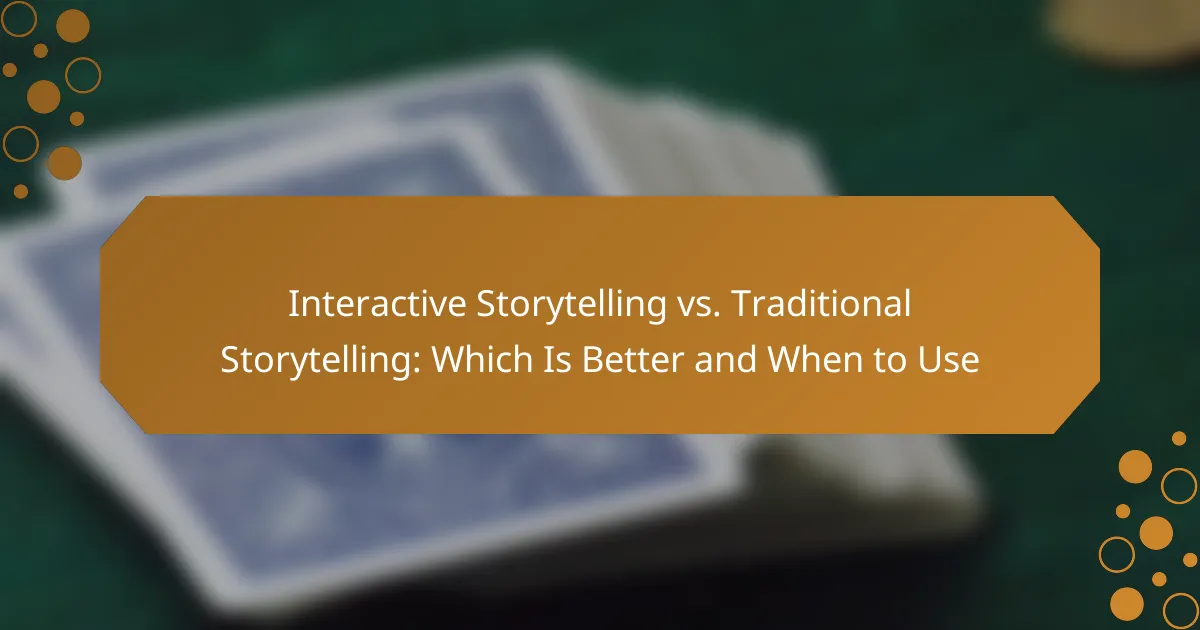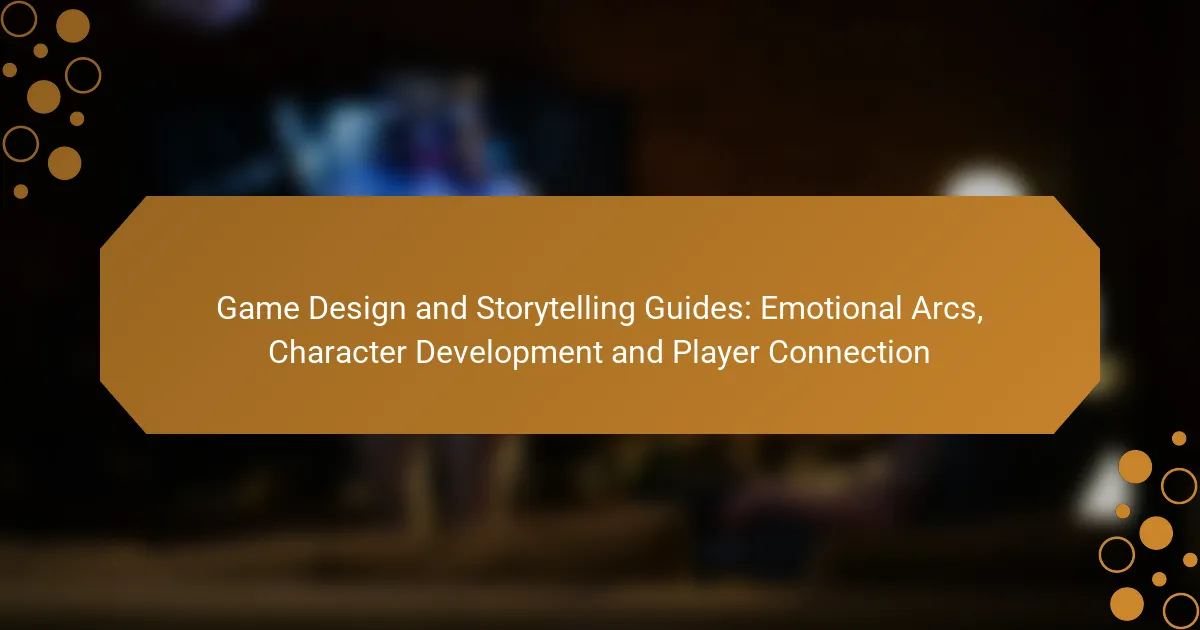In the evolving landscape of narrative forms, interactive storytelling and traditional storytelling each offer distinct advantages that cater to different audience needs and contexts. While interactive storytelling fosters engagement and personal investment by allowing audiences to shape the narrative, traditional storytelling provides a structured and emotionally resonant experience that appeals to a broader audience. Understanding when to use each approach can enhance the overall impact of the story being told.
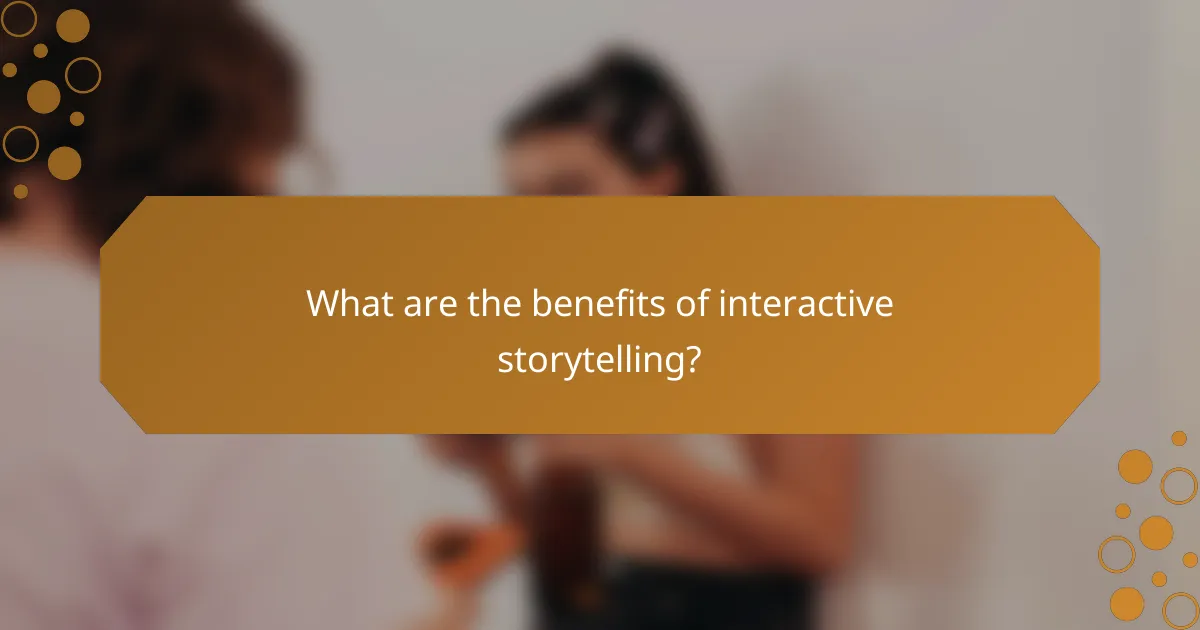
What are the benefits of interactive storytelling?
Interactive storytelling offers unique advantages that enhance user experience and engagement. By allowing audiences to influence the narrative, it creates a more immersive and personalized journey compared to traditional storytelling methods.
Enhanced user engagement
Interactive storytelling captivates users by involving them directly in the narrative. This active participation keeps audiences invested, as they make choices that affect the storyline, leading to deeper emotional connections with the content.
For example, video games often utilize interactive storytelling to engage players, making them feel like integral parts of the story. This level of involvement can significantly increase the time spent with the content, often resulting in hours of engagement.
Personalized experiences
One of the standout benefits of interactive storytelling is its ability to tailor experiences to individual users. By allowing choices that shape the narrative, each user can enjoy a unique story that resonates with their preferences and interests.
This personalization can range from simple character selections to complex decision-making paths that lead to different endings. Such tailored experiences can enhance satisfaction and encourage repeat interactions.
Improved retention rates
Interactive storytelling often leads to higher retention rates among users. When audiences actively participate in a story, they are more likely to remember the content and its messages.
Studies suggest that interactive formats can improve retention by up to 50% compared to passive consumption methods. This is particularly beneficial in educational contexts, where engagement can enhance learning outcomes.
Real-time feedback
Interactive storytelling allows for real-time feedback, enabling creators to gauge user reactions and preferences instantly. This immediate response can inform future content development and adjustments to enhance user satisfaction.
For instance, platforms that track user choices can analyze data to understand which story elements resonate most, allowing for continuous improvement and adaptation of the narrative experience.
Creative expression
Interactive storytelling provides creators with a platform for innovative expression. By blending various media formats—such as text, audio, and visuals—storytellers can craft rich, multi-layered narratives that engage users in diverse ways.
This format encourages experimentation, allowing creators to explore unconventional storytelling techniques and formats. As a result, interactive storytelling can push the boundaries of traditional narratives, offering fresh and exciting experiences for audiences.
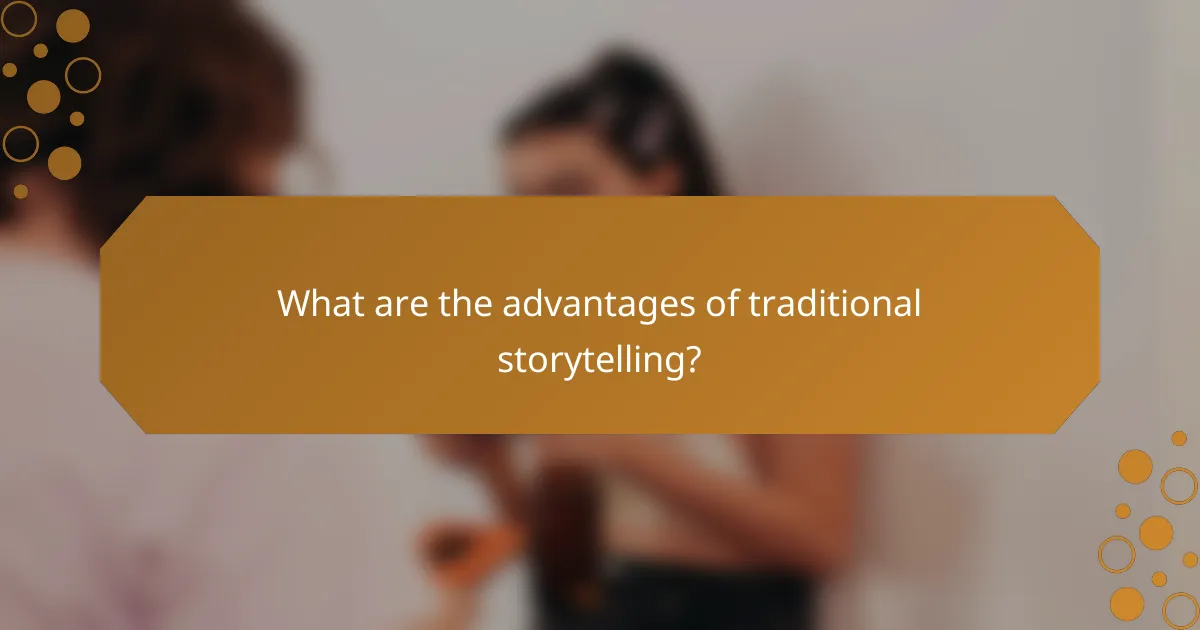
What are the advantages of traditional storytelling?
Traditional storytelling offers several key advantages, including a well-defined narrative structure, emotional depth, broader audience appeal, and ease of production. These strengths make it a reliable choice for various forms of media, from literature to film.
Established narrative structure
Traditional storytelling typically follows a clear narrative structure, such as the classic three-act format. This structure helps guide the audience through the story, ensuring that key elements like exposition, conflict, and resolution are effectively presented.
By adhering to established frameworks, creators can craft stories that resonate with audiences familiar with these patterns. This predictability can enhance engagement and satisfaction as viewers anticipate how the story will unfold.
Emotional depth
Traditional storytelling excels in developing emotional depth, allowing characters and their journeys to resonate with audiences on a personal level. Through detailed character development and relatable conflicts, stories can evoke strong feelings and connections.
For example, a well-crafted protagonist facing moral dilemmas can lead to profound emotional experiences for the audience, fostering empathy and reflection. This emotional engagement is often more challenging to achieve in interactive formats, where player choices can dilute character arcs.
Broader audience appeal
Traditional storytelling generally has broader audience appeal due to its familiarity and accessibility. Many people are accustomed to conventional narratives, making them more likely to engage with stories that follow these norms.
Additionally, traditional formats like novels and films can reach diverse demographics, as they do not require active participation or decision-making from the audience. This passive consumption can be more appealing for those seeking entertainment without the commitment of interactive storytelling.
Ease of production
Producing traditional stories is often more straightforward than creating interactive narratives. Writers can focus on crafting a cohesive storyline without the complexities of branching paths or player choices, which can significantly increase production time and costs.
For instance, a film can be shot in a linear fashion, allowing for a clear vision from script to screen. In contrast, interactive storytelling may require extensive testing and multiple iterations to ensure a seamless experience, complicating the production process.

When should you use interactive storytelling?
Interactive storytelling is best utilized when engagement and user participation are crucial to the experience. This approach allows audiences to influence the narrative, making it ideal for contexts where active involvement enhances understanding or connection.
Educational contexts
In educational settings, interactive storytelling can transform traditional learning into an engaging experience. For instance, using branching narratives in language learning can help students practice vocabulary in context, making lessons more memorable.
Consider incorporating quizzes or decision-making scenarios that require students to apply their knowledge. This method not only reinforces learning but also caters to different learning styles, enhancing retention and comprehension.
Marketing campaigns
Interactive storytelling is powerful in marketing, as it allows brands to create immersive experiences that resonate with consumers. Campaigns that let users choose their own adventure or customize their journey can significantly increase engagement rates.
For example, a fashion brand might use interactive storytelling to let users mix and match outfits in a virtual environment. This not only showcases products but also encourages sharing on social media, amplifying reach and impact.
Gaming experiences
In gaming, interactive storytelling is a fundamental element that drives player engagement. Games often allow players to make choices that affect the storyline, enhancing immersion and emotional investment.
Developers should focus on creating meaningful choices that influence outcomes, as this can lead to varied gameplay experiences. Titles like “The Witcher” series exemplify how player decisions can shape narratives, offering replayability and deeper connections to the story.
Brand storytelling
For brand storytelling, interactive elements can help convey a brand’s message in a memorable way. By allowing consumers to engage with the brand’s story through interactive content, companies can foster a stronger emotional connection.
Consider using interactive timelines or virtual tours that highlight a brand’s history and values. This approach not only informs but also invites consumers to participate, making the brand experience more personal and impactful.
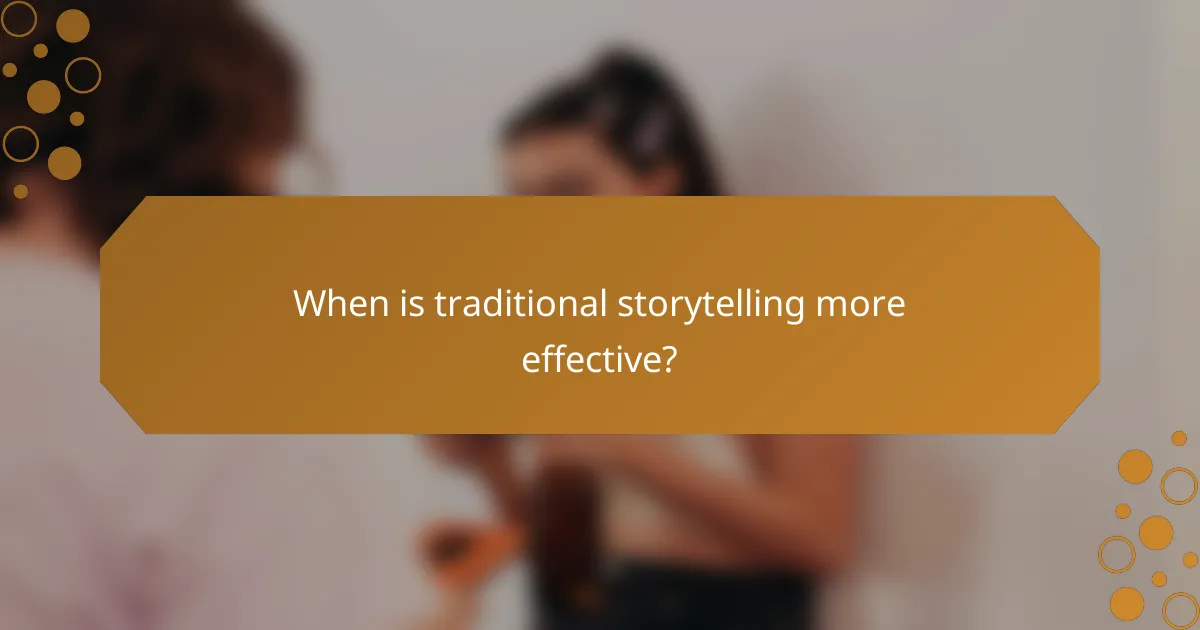
When is traditional storytelling more effective?
Traditional storytelling is often more effective when the narrative requires deep emotional engagement and a structured plot. This format allows for a focused exploration of themes and character development, making it ideal for certain mediums.
Literary works
In literary works, traditional storytelling excels in creating intricate plots and rich character arcs. Readers benefit from the author’s control over pacing and narrative depth, allowing for a more immersive experience. Classic novels often showcase this, where the journey of characters unfolds gradually, drawing readers into their world.
For example, works like “Pride and Prejudice” or “Moby Dick” rely on traditional storytelling to develop complex themes and character relationships, which can be challenging to convey in an interactive format.
Film and theater
Film and theater utilize traditional storytelling to guide audiences through a carefully crafted narrative arc. The visual and auditory elements enhance emotional impact, making it easier for viewers to connect with the story. A well-structured screenplay or stage play ensures that the audience remains engaged from beginning to end.
Consider films like “The Godfather” or plays like “Hamlet,” where the linear progression and character development are crucial for delivering the intended message and emotional resonance.
Podcasting
In podcasting, traditional storytelling can create a compelling auditory experience that captivates listeners. Narrative-driven podcasts often rely on a clear structure to maintain interest, using techniques like cliffhangers and character development to keep audiences engaged.
Popular examples include “Serial,” which uses a traditional storytelling format to unfold a true crime narrative, allowing listeners to become invested in the outcome.
Children’s literature
Children’s literature frequently employs traditional storytelling to convey morals and lessons in an accessible manner. Simple plots and relatable characters help young readers grasp complex ideas while enjoying the narrative. Books like “The Very Hungry Caterpillar” utilize straightforward storytelling to engage children and teach them about growth and change.
Additionally, the predictability of traditional storytelling can provide comfort to children, making them more likely to revisit their favorite stories and develop a love for reading.

How do you choose between interactive and traditional storytelling?
Choosing between interactive and traditional storytelling depends on your audience’s preferences and the goals of your narrative. Interactive storytelling engages users by allowing them to influence the plot, while traditional storytelling offers a linear experience with a set narrative.
Audience analysis
Understanding your audience is crucial when deciding between interactive and traditional storytelling. Consider their age, interests, and engagement levels. Younger audiences often prefer interactive formats, while older demographics may appreciate the depth of traditional narratives.
Conduct surveys or focus groups to gauge preferences. For instance, if your target audience enjoys gaming or interactive media, they might respond better to an interactive approach. Conversely, if they favor literature or film, traditional storytelling may resonate more.
Additionally, consider the context in which your audience will engage with the story. For example, interactive storytelling can be effective in educational settings, where engagement can enhance learning outcomes, while traditional storytelling might be better suited for formal presentations or literary events.
